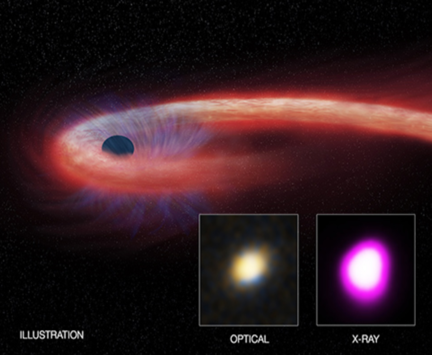Tidal Disruption Events
Stars are tidally disrupted and accreted when their self-gravity cannot balance the strong tidal force as they approach massive black holes (MBHs) closely enough, producing an electromagnetic flaring event, namely the Tidal Disruption Event (TDE, Figure 1), which is predicted to peak in the UV and soft X-ray regime based on theoretical models. TDE can be used as a powerful probe to detect and study MBHs in quiescent galaxies.
With its 0.5-4 keV soft X-ray bandpass, high sensitivity and unprecedented large field-of-view (thanks to the design of lobster-eye optics in EP/WXT), EP will be an extremely powerful instrument to discover and study TDEs in a systematic way. According to the luminosity function of the current X-ray detected TDE sample, we estimated an occurrence rate of 5×10-6 Mpc-3 yr-1 for TDEs with peak luminosity above 1043 erg s-1. We consider events that can be detected by EP/WXT within one-day’s operation in the normal survey mode, which has a range of accumulative dwell time with an average of ~ 6 kilo-seconds. Given the corresponding detection limits of EP/WXT (e.g. ~3×10-12 erg s-1 cm-2 for a 6-ks exposure in high Galactic latitude regions with |b|>30 deg.) and that only the night-sky is monitored, we estimate that EP will boost the number of known TDEs by one order of magnitude, including those involving MBH, IMBH and binary MBH system. This will result in a complete, flux-limited sample of X-ray selected TDEs which are essential for the study of TDE demography and taxonomy.
In addition to discovering, the onboard follow-up capability with FXT and continuing monitoring with WXT enable measurements of the X-ray spectra and X-ray light curves on both short- and long-timescales before sources fade beyond detection. This will produce a huge and time-evolving X-ray database, which will be extremely valuable for the study of accretion and jet physics. The resulting large, homogeneous sample of TDEs obtained by EP in several years’ operation will provide valuable constraints on the galactic occupation fraction of MBHs as well as the low-mass end of the mass function of MBHs, by combining the incidence of TDEs for various types of galaxies, which can be determined from simulations.
Observations of the early rising phase of TDEs may shed light on the formation of the accretion discs and, possibly, of the relativistic jets. They are elusive for the current facilities, however. The large field-of-view and high monitoring cadence of EP/WXT make it possible to capture the early rising phase for some of the TDEs to be detected by EP. Meanwhile, the immediate onboard autonomous observations with FXT and triggered multi-wavelength follow-ups will provide indispensable data to study the early phase, as well as to explore the entire cycle of TDEs from the onset of disruption till complete fading away. It will be even more interesting if a TDE involves a binary MBH system, in light of that such systems are potential sources of future gravitational-wave events. Consequently, EP is expected to bring major scientific breakthroughs to the research of TDE, MBH and other related fields in astrophysics.

Figure 1 Artist’s illustration of a TDE. Figure credit: X-ray: NASA/CXC/UNH/D. Lin et al, Optical: CFHT, Illustration: NASA/CXC/M.Weiss